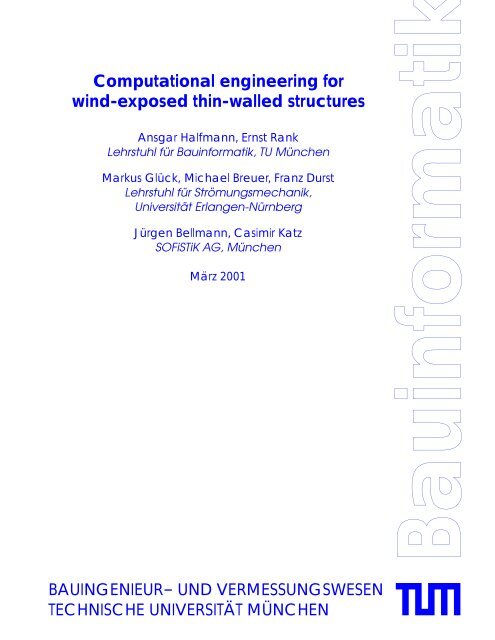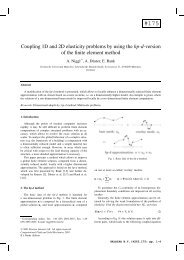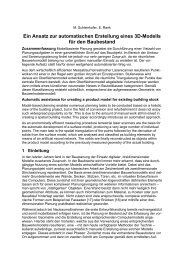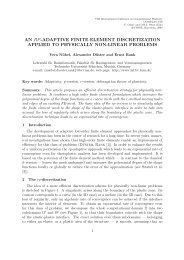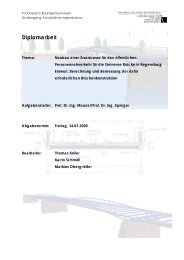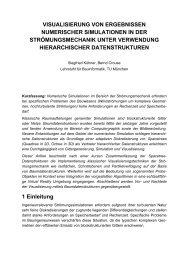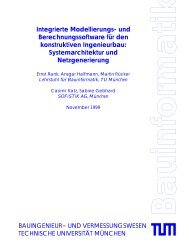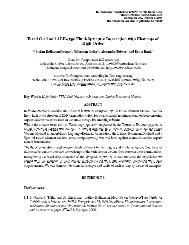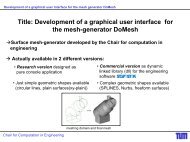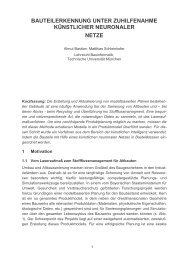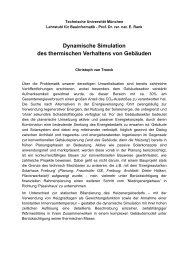Computational engineering for wind-exposed thin-walled structures
Computational engineering for wind-exposed thin-walled structures
Computational engineering for wind-exposed thin-walled structures
Create successful ePaper yourself
Turn your PDF publications into a flip-book with our unique Google optimized e-Paper software.
<strong>Computational</strong> <strong>engineering</strong> <strong>for</strong><br />
<strong>wind</strong>-<strong>exposed</strong> <strong>thin</strong>-<strong>walled</strong> <strong>structures</strong><br />
Ansgar Halfmann, Ernst Rank<br />
Lehrstuhl für Bauin<strong>for</strong>matik, TU München<br />
Markus Glück, Michael Breuer, Franz Durst<br />
Lehrstuhl für Strömungsmechanik,<br />
Universität Erlangen-Nürnberg<br />
Jürgen Bellmann, Casimir Katz<br />
SOFiSTiK AG, München<br />
März 2001<br />
Bauin<strong>for</strong>matik<br />
BAUINGENIEUR− UND VERMESSUNGSWESEN<br />
TECHNISCHE UNIVERSITÄT MÜNCHEN
Prof.Dr.rer.nat. Ernst Rank<br />
Lehrstuhl für Bauin<strong>for</strong>matik<br />
TECHNISCHE<br />
UNIVERSITÄT<br />
MÜNCHEN<br />
Fakultät für Bauingenieur- und Vermessungswesen<br />
Technische Universität München<br />
Arcisstr. 21<br />
D-80290 München<br />
email: rank@bv.tum.de Telefon: int++49 (89) 289 23048<br />
www: http://www.inf.bauwesen.tu-muenchen.de/ Telefax: int++49 (89) 289 25051
<strong>Computational</strong> <strong>engineering</strong> <strong>for</strong><br />
<strong>wind</strong>-<strong>exposed</strong> <strong>thin</strong>-<strong>walled</strong> <strong>structures</strong><br />
Ansgar Halfmann, Ernst Rank<br />
Lehrstuhl für Bauin<strong>for</strong>matik, TU München<br />
Markus Glück, Michael Breuer, Franz Durst<br />
Lehrstuhl für Strömungsmechanik,<br />
Universität Erlangen-Nürnberg<br />
Jürgen Bellmann, Casimir Katz<br />
SOFiSTiK AG, München<br />
März 2001
<strong>Computational</strong> <strong>engineering</strong> <strong>for</strong> <strong>wind</strong>-<strong>exposed</strong><br />
<strong>thin</strong>-<strong>walled</strong> <strong>structures</strong><br />
Ansgar Halfmann 1 , Ernst Rank 1 , Markus Gluck 2 ,Michael Breuer 2 ,Franz<br />
Durst 2 ,Jurgen Bellmann 3 , and Casimir Katz 3<br />
1 Lehrstuhl fur Bauin<strong>for</strong>matik, Technische Universitat Munchen, 80290 Munchen,<br />
Germany<br />
2 Lehrstuhl fur Stromungsmechanik, Universitat Erlangen-Nurnberg,<br />
91058 Erlangen, Germany<br />
3 SOFiSTiK AG, 81541 Munchen, Germany<br />
Abstract. In this paper a computer-aided simulation approach <strong>for</strong> uid-structure<br />
interaction of <strong>wind</strong>-<strong>exposed</strong> <strong>structures</strong> is presented. In the center of our software<br />
architecture is the geometric model of the structure, from which a nite element<br />
mesh <strong>for</strong> the structure and a nite volume mesh <strong>for</strong> the uid are derived. The<br />
attention is concentrated to <strong>thin</strong>-<strong>walled</strong> <strong>structures</strong> like membranes and <strong>thin</strong> shells<br />
composed of light and exible materials. The interaction of uid and structure is<br />
eected by <strong>wind</strong>-induced vibrations and causes large elastic de<strong>for</strong>mations of the<br />
structure. A powerful simulation tool is provided by couplingtwo codesdeveloped<br />
<strong>for</strong> ow simulation and structural dynamics by a fully implicit coupling algorithm.<br />
Results of three-dimensional simulations of uid-structure interaction <strong>for</strong> several<br />
test cases as well as <strong>for</strong> a real-life example will be presented.<br />
1 Introduction<br />
During the last few years much progress has been achieved to integrate<br />
analysis and design in civil <strong>engineering</strong> [9]. The computer-aided design process<br />
starts by setting up a geometric model being used <strong>for</strong> the denition<br />
of all structural properties as well as <strong>for</strong> the loads on the construction.<br />
From this geometric model a computational model is derived as the basis<br />
<strong>for</strong> the following dimensioning of the construction. This computer-aided<br />
<strong>engineering</strong> process has to support<br />
eciently the primary goals of any<br />
civil <strong>engineering</strong> design, i.e. the development<br />
of constructions satisfying<br />
the requirements of safety during<br />
their whole lifetime, resisting all<br />
expected inuences they might be<br />
<strong>exposed</strong> to. Considering <strong>for</strong> example<br />
light textile constructions like<br />
the convertible shade roof <strong>for</strong> a<br />
large court of the Prophet's Mosque<br />
in Madinah consisting of several Fig. 1. Convertible shade roof [10]
2 Ansgar Halfmann et al.<br />
large umbrellas (Fig. 1 [10]), the most demanding <strong>engineering</strong> task is to<br />
dimension the construction so that it will resist <strong>wind</strong> loads. Following the<br />
Davenport-Wind-Load-Chain an assumed local <strong>wind</strong> prole <strong>for</strong> a given terrain<br />
can be established according to the European Design Code EC 1 [5].<br />
This <strong>wind</strong> distribution causes a pressure eld on the structure. If simplied,<br />
conventional load assumptions <strong>for</strong> this pressure distribution are made, the<br />
<strong>structures</strong> may be strongly over-designed. Yet, also an under-design with the<br />
danger of a collapse may result from this simplied procedure, as the mutual<br />
inuence of neighbouring constructions could change the <strong>wind</strong> pressure eld<br />
dramatically. There<strong>for</strong>e, todays standard of practice are time-consuming and<br />
costly experiments in <strong>wind</strong> tunnels. A model of the construction is considered<br />
and <strong>wind</strong> pressure elds on its surface are measured to be used <strong>for</strong> later<br />
numerical structural analysis. One of the major drawbacks of this mixed computational<br />
and experimental approach is the diculty toquickly change the<br />
geometry of the model construction <strong>for</strong> the <strong>wind</strong> tunnel experiment. There<strong>for</strong>e,<br />
it would be highly desirable to have a'numerical <strong>wind</strong> tunnel' available,<br />
being directly integrated in the civil <strong>engineering</strong> design and analysis process,<br />
and enabling to investigate a structure also under the inuence of neighbouring<br />
constructions. Several steps in this direction have been per<strong>for</strong>med by the<br />
authors in a joint research project during the past two years and will be<br />
presented in this contribution.<br />
2 Software architecture<br />
The software architecture shown in Fig. 2 is inuenced by the idea of a loose<br />
coupling strategy based on highly specialized and well evaluated simulation<br />
codes, each developed <strong>for</strong> the special eld of the interacting system. In a<br />
rst step, the structural model is dened, using a classical CAD environment<br />
onaPCoraworkstation. Toconsider<br />
dierent stress distributions<br />
in a membrane, it is possible to<br />
compute the geometric shape of<br />
pure membrane <strong>structures</strong> in a<br />
<strong>for</strong>mnding process [2]. Thereby<br />
the de<strong>for</strong>med shape of the structure<br />
under dead load is computed<br />
by a nite element analysis starting<br />
from an inital geometry. Using<br />
special membrane elements<br />
and assuming an initial stiness<br />
caused by isotropic prestressing<br />
PC / workstation<br />
supercomputer<br />
STL-file<br />
ICEM-CFD<br />
fluid-simulation<br />
FASTEST-3D<br />
Geometrical Model<br />
+boundary conditions<br />
AutoCAD / SOFiPLUS<br />
<strong>for</strong>mfinding process<br />
MpCCI<br />
SOFiMESH<br />
DO_MESH<br />
structure-simulation<br />
ASE<br />
creates<br />
PC / workstation TECPLOT / Explorer Wingraf / Animator<br />
CDBASE<br />
Fig. 2. Software structure<br />
and neglecting any bending stiness, the de<strong>for</strong>med shape will lead to the<br />
soap lm <strong>for</strong>m with its constant isotropic stress distribution. All geometric<br />
in<strong>for</strong>mation is stored in a database describing a b-rep (boundary repre-
<strong>Computational</strong> <strong>engineering</strong> <strong>for</strong> <strong>wind</strong>-<strong>exposed</strong> <strong>thin</strong>-<strong>walled</strong> <strong>structures</strong> 3<br />
sentation) model completed by in<strong>for</strong>mation concerning material properties<br />
and boundary conditions [9]. For the structural part of the analysis system<br />
this project database represents a central module. All programs used<br />
<strong>for</strong> the structural simulation have access to the in<strong>for</strong>mation stored in the<br />
database. The geometric model <strong>for</strong> the uid dynamic part is also derived<br />
from the CAD model completed by boundary conditions and discretized as a<br />
block-structured three-dimensional grid being adequate to the nite volume<br />
technique. Due to extremely high computational requirements, the numerical<br />
simulation of the dynamic uid-structure interaction is per<strong>for</strong>med on a<br />
high-per<strong>for</strong>mance computer [8] in the next step. Thereby the data transfer between<br />
the two simulation codes, each running on dierent nodes/processors,<br />
is per<strong>for</strong>med via a common geometric model using a suitable coupling interface<br />
[1]. Finally, the results can be evaluated and visualized by powerful<br />
postprocessors on a workstation or on a PC.<br />
3 Coupling algorithm<br />
The uid-structure interaction is described by the structural de<strong>for</strong>mations<br />
as response to <strong>wind</strong> <strong>for</strong>ces, resulting in a modication of the uid ow domain.<br />
The coupling is per<strong>for</strong>med by a partitioned solution approach [3]. The<br />
<strong>Computational</strong> Fluid Dynamics (CFD) simulations are per<strong>for</strong>med by a nite<br />
volume based code [4] solving the Reynolds-Averaged-Navier-Stokes (RANS)<br />
equations using a two-equation k- model. It is adapted to moving grids<br />
by an Arbitrary Lagrangian Eulerian (ALE) <strong>for</strong>mulation. For the <strong>Computational</strong><br />
Structure Dynamics (CSD) the dynamic non-linear structural response<br />
(large displacements/small de<strong>for</strong>mations) is described by the equations of<br />
motion based on a nite element approach and an implicit time-stepping<br />
procedure [11]. For more details concerning the simulation codes we refer<br />
to [6]. The time-dependent simulation process is controlled by the coupling<br />
algorithm shown in Fig. 3. The<br />
solution is based on an iteration<br />
Fluid Structure<br />
procedure between the CFD<br />
and CSD simulation until convergence<br />
is reached wi<strong>thin</strong> each<br />
Solver<br />
inner iteration<br />
time-step. Thereby the nodal<br />
loads as input <strong>for</strong> the CSD<br />
Fluid solution<br />
outer FSI iteration<br />
simulation are computed from<br />
<strong>wind</strong> loads<br />
the results of the CFD simulation<br />
Solver<br />
time step<br />
(pressure and wall shear<br />
Structural solution<br />
stresses). The updated boundary<br />
displacements<br />
geometry is based on the structural<br />
displacements as a result of<br />
converged final solution<br />
the CSD simulation. In cases of<br />
large structural de<strong>for</strong>mations an<br />
Fig. 3. Coupling algorithm
4 Ansgar Halfmann et al.<br />
under-relaxation of the update of the boundary geometry was found to improve<br />
the convergence signicantly. A reduction of the number of iterations<br />
wi<strong>thin</strong> each time-step can be obtained by a predictor-corrector scheme [6].<br />
In<strong>for</strong>mations concerning the data transfer between the dierent numerical<br />
grids can be found in [7].<br />
4 Numerical examples<br />
The coupling procedure presented in the previous section was applied to<br />
several test cases. In the following the results of two elementary systems will<br />
be discussed with respect to dierent parameters <strong>for</strong> spatial and temporal<br />
discretization. Based on this, the coupled application was used to simulate<br />
the uid-structure interaction of a complex membrane structure.<br />
4.1 Vertical plate in a resting uid<br />
The rst example describes a temporarily loaded rectangular plate clamped at<br />
the lower boundary in a closed cavity of a resting uid. The dimensions of the<br />
exible plate pictured in Fig. 4 are length/width/thickness = 1.0/0.4/0.06 m.<br />
For the material properties a polyester with<br />
a modulus of elasticity of E = 2.5 MPa, a<br />
Poisson's ratio of =0:35 and a density of<br />
S = 2550 kg/m 3 is assumed. The density<br />
and dynamic viscosity of the uid are F =<br />
1kg/m 3 and F =0:2 Pa. Using these parameters,<br />
a laminar ow is expected. During<br />
the rst ve time-steps a constant load<br />
is applied in x-direction. After removing the<br />
Fig. 4. System conguration<br />
load the plate executes oscillations induced by the initial deection damped<br />
by the surrounding uid ow.<br />
In a rst simulation the inuence of the time-step size was investigated.<br />
The uid domain was discretized by 1650 hexaeder elements, yielding 10<br />
quadrilateral elements to describe the interface. For the structural simulation<br />
a surface mesh of 8 elements was chosen. Both surface discretizations are<br />
shown in Fig. 5. Due to the boundary conditions <strong>for</strong> the uid simulation<br />
the results of the coupled three-dimensional simulation shows a quasi twodimensional<br />
behavior. Fig. 6 points out the computed displacement of the<br />
upper boundary of the plate <strong>for</strong> simulations with three dierent time-step<br />
sizes. The amplitude of the plate oscillation is damped by theambient uid.<br />
For the dierent time-step sizes only small deviations could be identied.<br />
There<strong>for</strong>e, t 1 =0:025 s was chosen <strong>for</strong> the following simulations.<br />
The dependence of the displacement on dierent spatial discretizations<br />
is depicted in Fig. 8. Starting again from a discretization of 1650 hexaeder<br />
elements <strong>for</strong> the uid domain (10 quadrilaterals on the interface, Fig. 7) a
<strong>Computational</strong> <strong>engineering</strong> <strong>for</strong> <strong>wind</strong>-<strong>exposed</strong> <strong>thin</strong>-<strong>walled</strong> <strong>structures</strong> 5<br />
250<br />
CFD<br />
18 nodes,<br />
10 elements<br />
CSD<br />
15 nodes,<br />
8 elements<br />
Fig. 5. Discretization of the interface<br />
displacement upper boundary [mm]<br />
200<br />
150<br />
100<br />
50<br />
0<br />
−50<br />
−100<br />
−150<br />
t 1 = 0:025 s<br />
t 2 = 0:0125 s<br />
t 3 = 0:00625 s<br />
−200<br />
0 0.5 1 1.5 2 2.5 3 3.5<br />
time [s]<br />
Fig. 6. Displacement <strong>for</strong> dierent t<br />
uni<strong>for</strong>m renement was per<strong>for</strong>med in two levels which leads to 13,200<br />
and 105,600 hexaeder elements and 40 or 160 quadrilaterals <strong>for</strong> the interface,<br />
respectively. The coarsest grid <strong>for</strong> the CSD simulation consisting of only 2<br />
elements is also shown in Fig. 7. Uni<strong>for</strong>m renement yields surface meshes of<br />
8 or 32 quadrilateral elements <strong>for</strong> the structure simulation, respectively.<br />
CFD<br />
18 nodes,<br />
10 elements<br />
CSD<br />
6nodes,<br />
2 elements<br />
Fig. 7. Initial interface discretization<br />
displacement upper boundary [mm]<br />
300<br />
250<br />
200<br />
150<br />
100<br />
50<br />
0<br />
−50<br />
−100<br />
−150<br />
CFD10=CSD 2<br />
CFD40=CSD 8<br />
CFD160=CSD 32<br />
−200<br />
0 0.1 0.2 0.3 0.4 0.5 0.6 0.7 0.8 0.9 1<br />
time [s]<br />
Fig. 8. Displacement <strong>for</strong> dierent interface<br />
discretizations<br />
Fig.8points out the insucient accuracy of the results corresponding to<br />
the initial interface discretizations and the good agreement of the transient<br />
displacements achieved with the rened meshes. In particular the CSD mesh<br />
consisting only of 2 elements <strong>for</strong> the y-direction is too coarse to obtain useful<br />
results.<br />
4.2 Vertical plate under a sudden <strong>wind</strong> gust<br />
The geometry and material properties of the second test case are the same<br />
as be<strong>for</strong>e. Fig. 9 shows a cutting plane through the uid domain which is<br />
open with an inlet (left boundary), an outlet (right boundary), and symmetric<br />
boundary conditions at the top as well as in z-direction. At the beginning<br />
of the coupled simulation the uid suddenly accelerates and adopts
6 Ansgar Halfmann et al.<br />
immediately a constant inowvelocity<br />
ofU1 = 10 m/s being equivalent<br />
to a Reynolds number of Re L =50.<br />
As a consequence the structural oscillations<br />
are induced by the saltus<br />
of the uid velocity and reach a<br />
stationary de<strong>for</strong>mation state after a<br />
certain time. Fig. 10 shows again the<br />
displacement of the upper boundary<br />
of the plate <strong>for</strong> various timestep<br />
sizes. The interface discretizations<br />
comply to the grids pictured in<br />
Fig. 5. Only minor distinctions could<br />
be identied <strong>for</strong> the dierent time<br />
discretizations. Furthermore, the in-<br />
uence of the spatial interface discretization<br />
was investigated using<br />
the grids shown in Fig.11 and per<strong>for</strong>ming<br />
an uni<strong>for</strong>m renement of<br />
two levels <strong>for</strong> the CSD grid whereas<br />
the mesh <strong>for</strong> the uid domain remains<br />
unchanged. It is again obvious<br />
displacement upper boundary [mm]<br />
U<br />
8<br />
70<br />
60<br />
50<br />
40<br />
30<br />
20<br />
10<br />
y<br />
1111111111111111111111111111111111111111111111111111111111111<br />
0000000000000000000000000000000000000000000000000000000000000<br />
1111111111111111111111111111111111111111111111111111111111111<br />
0000000000000000000000000000000000000000000000000000000000000<br />
A<br />
Fig. 9. System conguration<br />
0<br />
0 0.5 1 1.5 2 2.5 3 3.5<br />
time [s]<br />
B<br />
L<br />
t 1 = 0:025 s<br />
t 2 = 0:0125 s<br />
t 3 = 0:00625 s<br />
t 4 = 0:003125 s<br />
t 5 = 0:0015625 s<br />
Fig. 10. Displacement <strong>for</strong> dierent t<br />
that the bending oscillations of the plate cannot be represented suciently<br />
accurate by a CSD mesh with only two elements in y-direction, see Fig. 12.<br />
x<br />
CFD<br />
18 nodes,<br />
10 elements<br />
CSD<br />
9nodes,<br />
4 elements<br />
Fig. 11. Initial interface discretization<br />
displacement upper boundary [mm]<br />
60<br />
50<br />
40<br />
30<br />
20<br />
10<br />
CFD10=CSD 4<br />
CFD10=CSD 6<br />
CFD10=CSD 8<br />
0<br />
0 0.5 1 1.5 2 2.5 3 3.5<br />
time [s]<br />
Fig. 12. Displacement <strong>for</strong> dierent CSD<br />
interface discretizations<br />
4.3 Tent roof<br />
Fig. 13 shows a screenshot of the CAD-environment representing the geometric<br />
model of a real-life structure as a starting point <strong>for</strong> the simulation.
<strong>Computational</strong> <strong>engineering</strong> <strong>for</strong> <strong>wind</strong>-<strong>exposed</strong> <strong>thin</strong>-<strong>walled</strong> <strong>structures</strong> 7<br />
The shape of the structure is a result of the <strong>for</strong>mnding process sketched<br />
in Section 2 and species a textile roof being positioned in front of an oce<br />
building. A material of glass-bre synthetics with a thickness of 1.5 mm, a<br />
modulus of elasticity ofE =3000MPa, and a shear modulus of G =1500<br />
MPa is assumed. The structure is 24 m long and shows a width between 3<br />
m and 8.5 m. The boundary of the block-structured three-dimensional CFD<br />
grid on the interface and the CSD surface grid are shown in Fig. 14 and 15.<br />
Due to the fact that the k- model produces non-physical results <strong>for</strong> such<br />
complex geometries the CFD simulations were per<strong>for</strong>med neglecting turbulence<br />
in this rst step. The velocity distribution of the assumed <strong>wind</strong> gust and<br />
the displacement as structural response are pictured <strong>for</strong> four dierent timesteps<br />
in Fig. 16. The gust leads to a maximal displacement in z-direction of<br />
z max =31cm.<br />
3536 nodes,<br />
3400 elements<br />
Fig. 14. CFD interface discretization<br />
1409 nodes,<br />
1311 elements<br />
Fig. 13. Geometry of the tent roof<br />
Fig. 15. CSD interface discretization<br />
Fig. 16. Velocity distributions and diplacements of four dierent time-steps<br />
(t 1 =2:0 s,t 2 =3:0 s,t 3 =4:36 s and t 4 =4:46 s)
8 Ansgar Halfmann et al.<br />
5 Conclusions<br />
The partitioned solution approach has been investigated <strong>for</strong> the simulation of<br />
uid-structure interaction of light civil <strong>engineering</strong> constructions under <strong>wind</strong><br />
load. Be<strong>for</strong>e the outlined concept could be a practically used procedure, it will<br />
be necessary to incorporate more elaborate turbulence modeling such as largeeddy<br />
simulation, per<strong>for</strong>m more numerical tests and compare the numerical<br />
results with veried experimental data. If thus sucient condence is gained<br />
in this simulation technique, it can be an application of high-per<strong>for</strong>mance<br />
computing with signicant impact on <strong>engineering</strong> practice.<br />
Acknowledgements<br />
The work was nanced by the Bayerische Forschungsstiftung in the Bavarian<br />
Consortium of High-Per<strong>for</strong>mance Scientic Computing, FORTWIHR (III).<br />
The simulations were partially carried out on the Hitachi SR8000-F1 at the<br />
LRZ Munchen [8]. This support is gratefully acknowledged.<br />
References<br />
1. Ahrem, R., Hackenberg, M.G., Post, P., Redler, R., Roggenbuck, J. (2000)<br />
MpCCI { Mesh Based Parallel Code Coupling Interface. Institute <strong>for</strong> Algorithms<br />
and Scientic Computing (SCAI), GMD, http://www.mpcci.org/<br />
2. Bellmann, J. (1998) Membrantragwerke und Seifenhaut { Unterschiede in der<br />
Formndung. Bauingenieur, 3/98, 118{123<br />
3. Cebral, J.R. (1996) Loose Coupling Algorithms <strong>for</strong> Fluid-Structure Interaction.<br />
Ph.D.-Thesis, George Mason University Fairfax, Virginia<br />
4. Durst, F., Schafer, M. (1996) A Parallel Block{Structured Multigrid Method<br />
<strong>for</strong> the Prediction of Incompressible Flows. Int. J. Num. Methods Fluids 22,<br />
549{565<br />
5. EUROCODE 1 (1995) Basis of Design and Actions on Structures Part 2-4: Actions<br />
on Structures - Wind Actions. European Committee <strong>for</strong> Standardization<br />
Ref. No. ENV 1991-2-4<br />
6. Gluck, M., Breuer, M., Durst, F., Halfmann, A., Rank, E. (2000) Computation<br />
of Fluid-Structure Interaction on Lightweight Structures. Proceedings of<br />
Fourth International Colloquium on Blu Body Aerodynamics & Applicastions,<br />
Bochum, To appear in J. of Wind Engineering and Industrial Aerodynamics<br />
7. Halfmann, A., Rank, E., Gluck, M., Breuer, M., Durst, F. (2000) A Partitioned<br />
Solution Approach <strong>for</strong> the Fluid-Structure Interaction of Wind and<br />
Thin-Walled Structures. Proceedings of IKM 2000, Weimar<br />
8. http://www.lrz-muenchen.de/services/compute/hlrb/.<br />
9. Rank, E., Halfmann, A., Rucker, M., Katz, C., Gebhard, S. (2000) Integrierte<br />
Modellierungs- und Berechnungssoftware fur den konstruktiven Ingenieurbau:<br />
Systemarchitektur und Netzgenerierung. Bauingenieur, Februar 2000, 60{66<br />
10. Sonderkonstruktionen und Leichtbau GmbH (1993) The Work of SL.<br />
Leinfelden-Oberaichen<br />
11. SOFiSTiK AG (2000) ASE{Handbuch. Munchen


